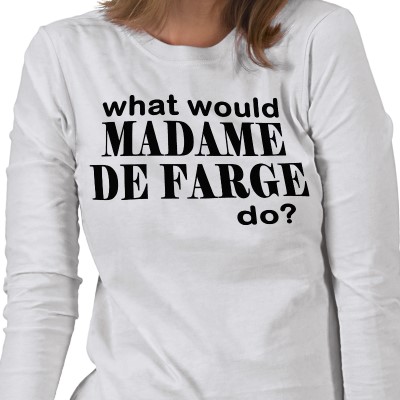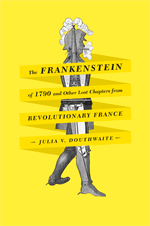Madame Defarge’s belated Bastille Day quiz
 Traditionally, Bastille Day celebrates in perpetua an inaugural anniversary (1790’s Fête de la Fédération), itself commemorating an infamous fortress-prison’s storming (July 14, 1789) that tipped-off the eighteenth century’s uprising among uprisings. Vive la démocratie!
Traditionally, Bastille Day celebrates in perpetua an inaugural anniversary (1790’s Fête de la Fédération), itself commemorating an infamous fortress-prison’s storming (July 14, 1789) that tipped-off the eighteenth century’s uprising among uprisings. Vive la démocratie!
How does one celebrate Bastille Day? Once, when very young and in Battery Park, by listening to Stereolab play a set after Yoko Ono. Now, many years later and much more curmudgeon-like, with Defargian undertones acknowledged (“. . . opportunity had developed her into a tigress. She was absolutely without pity. If she had ever had the virtue in her, it had quite gone out of her.”), I’m not so sure. Hopefully this Saturday past found you tipping a glass of Burgundy to the Declaration of the Rights of Man and of the Citizen, or at least re-reading Peter Weiss’s Marat/Sade—if not, thankfully, we have Julia V. Douthwaite to school us, quiz-bowl style, on what we were missing out on.
 In The Frankenstein of 1790 and Other Lost Chapters from Revolutionary France, Douthwaite posits the French Revolution as a key moment in the history of printed matter, a period that—fueled by the passions of political change and its accompanying fervor for new forms, new ideas, and most importantly, new stories—ushered in the publication of more than 1200 novels, including those by Mary Shelley, E. T. A. Hoffmann, Honoré de Balzac, Charles Dickens, Gustave Flaubert, and L. Frank Baum. This builds off of Douthwaite’s earlier work as a scholar of the “wild children” of the eighteenth-century, in the moments prior to the Revolution, when utopian politics, dystopian fictions, and the changing boundaries of nature and science met with the desire to “perfect” mankind—to disastrous results. Douthwaite chronicles all of this in The Wild Girl, Natural Man, and the Monster: Dangerous Experiments in the Age of Enlightenment.
In The Frankenstein of 1790 and Other Lost Chapters from Revolutionary France, Douthwaite posits the French Revolution as a key moment in the history of printed matter, a period that—fueled by the passions of political change and its accompanying fervor for new forms, new ideas, and most importantly, new stories—ushered in the publication of more than 1200 novels, including those by Mary Shelley, E. T. A. Hoffmann, Honoré de Balzac, Charles Dickens, Gustave Flaubert, and L. Frank Baum. This builds off of Douthwaite’s earlier work as a scholar of the “wild children” of the eighteenth-century, in the moments prior to the Revolution, when utopian politics, dystopian fictions, and the changing boundaries of nature and science met with the desire to “perfect” mankind—to disastrous results. Douthwaite chronicles all of this in The Wild Girl, Natural Man, and the Monster: Dangerous Experiments in the Age of Enlightenment.
Who better, then, to serve as our quiz-master about the legacy of the French Revolution and why there’s more to those fireworks on the Champs-Élysées than meets the eye? NB: it’s a tough one, so don’t get your (sans-)culottes in a bunch if at first you don’t succeed. Answers—and a bit of historical rationale—follow, after the multiple choice.
May the petty criminals be pardoned, as you run naked through the streets!
Julia v. Douthwaite’s Bastille Day Quiz (in which Madame Defarge would refuse to style her name as “Madame De Farge,” lucrative t-shirt branding opportunities aside)